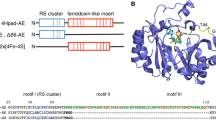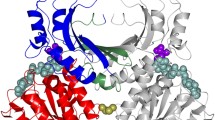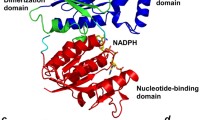Abstract
The interaction of several dehydrogenases with the electron transferring flavoprotein (ETF) is a crucial step required for the successful transfer of electrons into the electron transport chain. The exact determinants regarding the interaction of ETF with its dehydrogenase partners are still unknown. Chemical modification of ETF with arginine-specific reagents resulted in the loss, to varying degrees, of activity with medium chain acyl-coenzyme A dehydrogenase (MCAD). The kinetic profiles showed the inactivations followed pseudo-first-order kinetics for all reagents used. For activity with MCAD, maximum inactivation of ETF was accomplished by 2,3-butanedione (4% residual activity after 120 min) and it was shown that modification of one arginine residue was responsible for the inactivation. Almost 100% restoration of this ETF activity was achieved upon incubation with free arginine. However, the same 2,3-butanedione modified ETF only possessed decreased activity with dimethylglycine- (DMGDH, 44%) and sarcosine- (SDH, 27%) dehydrogenases unlike the abolition with MCAD. Full protection of ETF from arginine modification by 2,3-butanedione was achieved using substrate-protected DMGDH, MCAD and SDH respectively. Cross-protection studies of ETF with the three dehydrogenases implied use of the same single arginine residue in the binding of all three dehydrogenases. These results lead us to conclude that this single arginine residue is essential in the binding of the ETF to MCAD, but only contributes partially to the binding of ETF to SDH and DMGDH and thus, the determinants of the dehydrogenase binding sites overlap but are not identical.
Similar content being viewed by others
References
Thorpe C: In: F. Muller (ed). Chemistry and Biochemistry of Flavoenzymes, vol. III. CRC Press, Boca Raton, FL, 1991, pp 471-486
Gorelick RJ, Mizzer JP, Thorpe C: Purification and properties of electron-transferring flavoprotein from pig kidney. Biochemistry 21: 6936-6942, 1982
Husain M, Steenkamp DJ: Electron transfer flavoprotein from pig liver mitochondria. A simple purification and re-evaluation of some of the molecular properties. Biochem J 209: 541-545, 1983
Husain M, Steenkamp DJ: Partial purification and characterization of glutaryl-coenzyme A dehydrogenase, electron transfer flavoprotein, and electron transfer flavoprotein-Q oxidoreductase from Paracoccus denitrificans. J Bacteriol 163: 709-715, 1985
Ikeda Y, Keese SM, Tanaka K: Biosynthesis of electron transfer flavoprotein in a cell-free system and in cultured human fibroblasts. Defect in the alpha subunit synthesis is a primary lesion in glutaric aciduria type II. J Clin Invest 78: 997-1002, 1986
Steenkamp DJ, Gallup M: The natural flavorprotein electron acceptor of trimethylamine dehydrogenase. J Biol Chem 253: 4086-4089, 1978
Furuta S, Miyazawa S, Hashimoto T: Purification and properties of rat liver acyl-CoA dehydrogenases and electron transfer flavoprotein. J Biochem (Tokyo) 90: 1739-1750, 1981
Whitfield CD, Mayhew SG: Purification and properties of electron-transferring flavoprotein from Peptostreptococcus elsdenii. J Biol Chem 249: 2801-2810, 1974
Roberts DL, Salazar D, Fulmer JP, Frerman FE, Kim JJ: Crystal structure of Paracoccus denitrificans electron transfer flavoprotein: Structural and electrostatic analysis of a conserved flavin binding domain. Biochemistry 38: 1977-1989, 1999
Roberts DL, Frerman FE, Kim JJ: Three-dimensional structure of human electron transfer flavoprotein to 2.1-A resolution. Proc Natl Acad Sci USA 93: 14355-14360, 1996
Sato K, Nishina Y, Shiga K: Electron-transferring flavoprotein has an AMP-binding site in addition to the FAD-binding site. J Biochem (Tokyo) 114: 215-222, 1993
DuPlessis ER, Rohlfs RJ, Hille R, Thorpe C: Electron-transferring flavoprotein from pig and the methylotrophic bacterium W3A1 contains AMP as well as FAD. Biochem Mol Biol Int 32: 195-199, 1994
Beinert H: In: P.D. Boyer, H. Lardy, K. Myrbuck (eds). The Enzymes. Academic Press, New York, 1963
Hall CL, Heijkenskjold L, Bartfai T, Ernster L, Kamin H: Acyl coenzyme A dehydrogenases and electron-transferring flavoprotein from beef hart mitochondria. Arch Biochem Biophys 177: 402-414, 1976
Noda C, Rhead WJ, Tanaka K: Isovaleryl-CoA dehydrogenase: Demonstration in rat liver mitochondria by ion exchange chromatography and isoelectric focusing. Proc Natl Acad Sci USA 77: 2646-2650, 1980
Ruzicka FJ, Beinert H: A new iron-sulfur flavoprotein of the respiratory chain. A component of the fatty acid beta oxidation pathway. J Biol Chem 252: 8440-8445, 1977
Hall CL: Electron-transfer flavoprotein from pig liver mitochondria. Meth Enzymol 71: 386-390, 1977
Ikeda Y, Okamura-Ikeda K, Tanaka K: Purification and characterization of short-chain, medium-chain, and long-chain acyl-CoA dehydrogenases from rat liver mitochondria. Isolation of the holo-and apoenzymes and conversion of the apoenzyme to the holoenzyme. J Biol Chem 260: 1311-1325, 1985
Izai K, Uchida Y, Orii T, Yamamoto S, Hashimoto T: Novel fatty acid beta-oxidation enzymes in rat liver mitochondria. I. Purification and properties of very-long-chain acyl-coenzyme A dehydrogenase. J Biol Chem 267: 1027-1033, 1992
Eder M, Krautle F, Dong Y, Vock P, Kieweg V, Kim JJ, Strauss AW, Ghisla S: Characterization of human and pig kidney long-chain-acyl-CoA dehydrogenases and their role in beta-oxidation. Eur J Biochem 245: 600-607, 1997
Ikeda Y, Tanaka K: Purification and characterization of isovaleryl coenzyme A dehydrogenase from rat liver mitochondria. J Biol Chem 258: 1077-1085, 1983
Lenich AC, Goodman SI: The purification and characterization of glutaryl-coenzyme A dehydrogenase from porcine and human liver. J Biol Chem 261: 4090-4096, 1986
Ikeda Y, Tanaka K: Purification and characterization of 2-methyl-branched chain acyl coenzyme A dehydrogenase, an enzyme involved in the isoleucine and valine metabolism, from rat liver mitochondria. J Biol Chem 258: 9477-9487, 1983
Frishell WR, McKenzie CG: Purification and characterization of two folate binding proteins. J Biol Chem 237: 94-98, 1962
Zhang J, Zhang W, Zou D, Chen G, Wan T, Zhang M, Cao X: Cloning and functional characterization of ACAD-9, a novel member of human acyl-CoA dehydrogenase family. Biochem Biophys Res Commun 297: 1033-1038, 2002
Telford EA, Moynihan LM, Markham AF, Lench NJ: Isolation and characterisation of a cDNA encoding the precursor for a novel member of the acyl-CoA dehydrogenase gene family. Biochim Biophys Acta 1446: 371-376, 1999
Przyrembel H, Wendel U, Becker K, Bremer HJ, Bruinvis L, Ketting D, Wadman SK: Glutaric aciduria type II: Report on a previously undescribed metabolic disorder. Clin Chim Acta 66: 227-239, 1976
Jones M, Talfournier F, Bobrov A, Grossmann JG, Vekshin N, Sutcliffe MJ, Scrutton NS: Electron transfer and conformational change in complexes of trimethylamine dehydrogenase and electron transferring flavoprotein. J Biol Chem 277: 8457-8465, 2002
Frerman FE, Mielke D, Huhta K: The functional role of carboxyl residues in an acyl-CoA dehydrogenase. J Biol Chem 255: 2199-2202, 1980
Beckmann JD, Frerman FE: The effects of pH, ionic strength, and chemical modifications on the reaction of electron transfer flavoprotein with an acyl coenzyme A dehydrogenase. J Biol Chem 258: 7563-7569, 1983
Beckmann JD, Frerman FE: Reaction of electron-transfer flavoprotein with electron-transfer flavoprotein-ubiquinone oxidoreductase. Biochemistry 24: 3922-3925, 1985
Parker A, Engel PC: 5.5′-Dithiobis-(2-nitrobenzoic acid) as a probe for a non-essential cysteine residue at the medium chain acyl-coenzyme A dehydrogenase binding site of the human electron transferring flavoprotein (ETF). J Enzyme Inhib 14: 381-390, 1999
Wittwer AJ, Wagner C: Identification of the folate-binding proteins of rat liver mitochondria as dimethylglycine dehydrogenase and sarcosine dehydrogenase. Purification and folate-binding characteristics. J Biol Chem 256: 4102-4108, 1981
Thorpe C: Acyl-CoA dehydrogenase from pig kidney. Meth Enzymol 71: 366-374, 1981
Wittwer AJ, Wagner C: Identification of folate binding protein of mitochondria as dimethylglycine dehydrogenase. Proc Natl Acad Sci USA 77: 4484-4488, 1980
Bradford MM: A rapid and sensitive method for the quantitation of microgram quantities of protein utilizing the principle of protein-dye binding. Anal Biochem 72: 248-254, 1976
Riordan JF: Functional arginyl residues in carboxypeptidase A. Modification with butanedione. Biochemistry 12: 3915-3923, 1973
Kuno S, Toraya T, Fukui S: Coenzyme B12-dependent diol dehydrase: Chemical modification with 2,3-butanedione and phenylglyoxal. Arch Biochem Biophys 205: 240-245, 1980
Chang GG, Huang TM: Modification of essential arginine residues of pigeon liver malic enzyme. Biochim Biophys Acta 660: 341-347, 1981
Takahashi K: The reaction of phenylglyoxal with arginine residues in proteins. J Biol Chem 243: 6171-6179, 1968
Feeney RE, Means GE: Chemical Modification of Proteins. Holden Day Inc., 1971
Bell JE, Bell ET: Proteins and Enzymes. Prentice-Hall, NJ, 1988
Jiang ZY, Thorpe C: Modification of an arginine residue in pig kidney general acyl-coenzyme A dehydrogenase by cyclohexane-1,2-dione. Biochem J 207: 415-419, 1982
Adak S, Mazumder A, Banerjee RK: Probing the active site residues in aromatic donor oxidation in horseradish peroxidase: Involvement of an arginine and a tyrosine residue in aromatic donor binding. Biochem J 314: 985-991, 1996
Kotsira VP, Clonis YD: Chemical modification of barley root oxalate oxidase shows the presence of a lysine, a carboxylate, and disulfides, essential for enzyme activity. Arch Biochem Biophys 356: 117-126, 1998
Herrick KR, Salazar D, Goodman SI, Finocchiaro G, Bedzyk LA, Frerman FE: Expression and characterization of human and chimeric human-Paracoccus denitrificans electron transfer flavoproteins. J Biol Chem 269: 32239-32245, 1994
Steenkamp DJ: Cross-linking of the electron-transfer flavoprotein to electron-transfer flavoprotein-ubiquinone oxidoreductase with heterobifunctional reagents. Biochem J 255: 869-876, 1988
Steenkamp DJ: Preferential cross-linking of the small subunit of the electron-transfer flavoprotein to general acyl-CoA dehydrogenase. Biochem J 243: 519-524, 1987
Author information
Authors and Affiliations
Rights and permissions
About this article
Cite this article
Parker, A.R. A single arginine residue is required for the interaction of the electron transferring flavoprotein (ETF) with three of its dehydrogenase partners. Mol Cell Biochem 254, 91–100 (2003). https://doi.org/10.1023/A:1027349303797
Issue Date:
DOI: https://doi.org/10.1023/A:1027349303797




